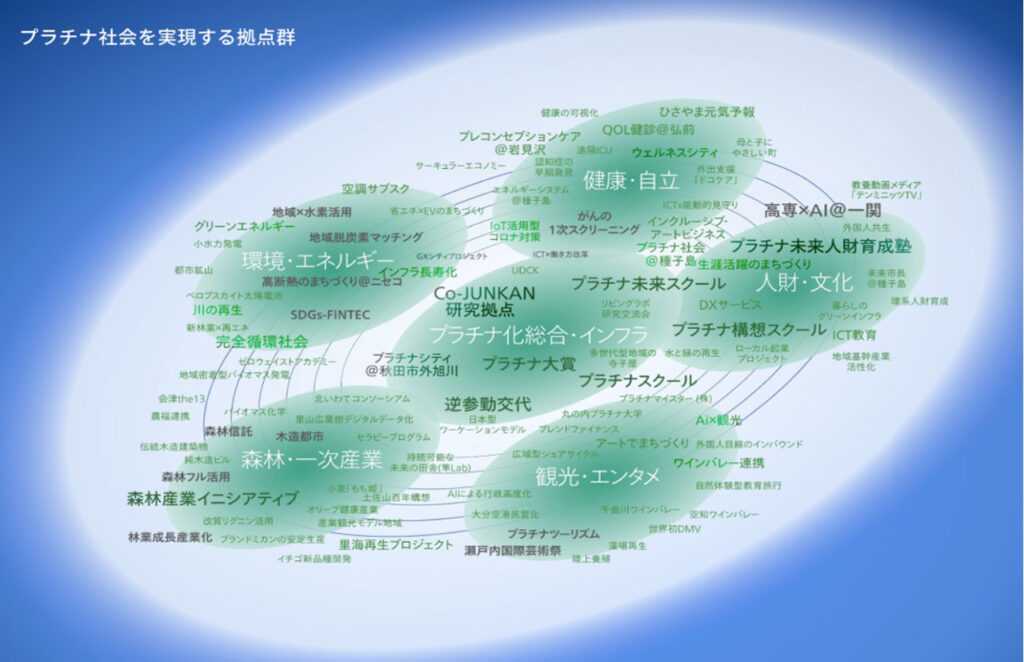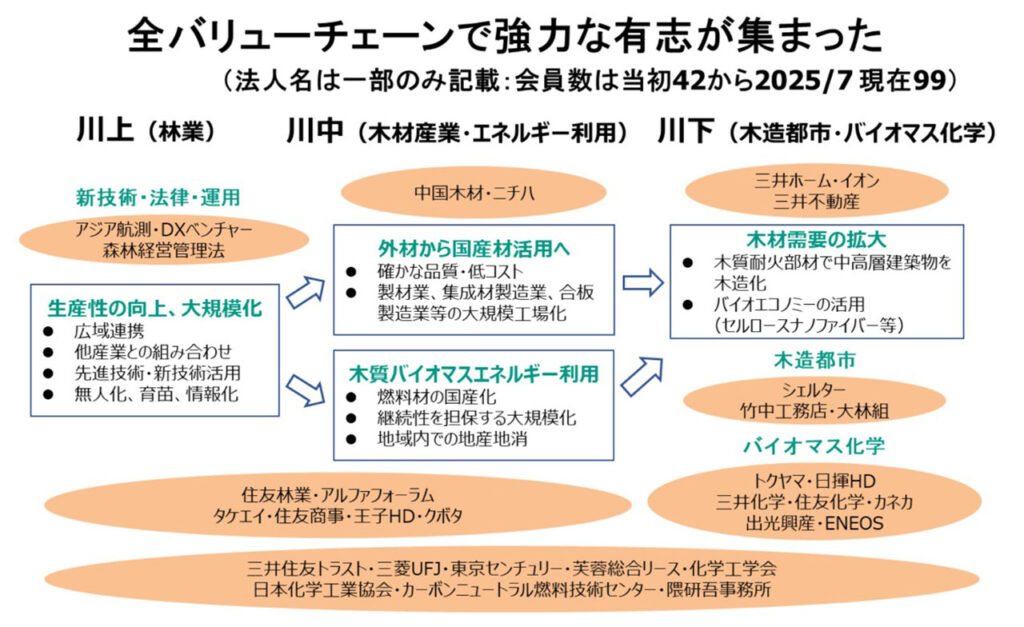Why Japan needs a "forest circular economy" now: Determination to aim for a platinum society based on resource self-sufficiency, lifelong growth, and resident investment
Updated by Hiroshi Komiyama on August 12, 2025, 9:16 PM JST
Hiroshi KOMIYAMA
(Platinum Initiative Network, Inc.
After serving as Professor at the University of Tokyo, Dean of the Graduate School of Engineering and Dean of the Faculty of Engineering, and President of the University of Tokyo (28th), he was appointed Chairman of the Mitsubishi Research Institute in 2009, and Chairman of the Platinum Initiative Network in 2010 (to be incorporated as a general incorporated association in 2022). Other positions include President of the STS Forum, Chairman of the Association for Super-Education, Chairman of the United Nations University Cooperation Foundation, Chairman of the International Science and Technology Foundation, and Chairman of the Heat Pump and Thermal Storage Center Foundation. He also received the Dubai Knowledge Award (2017), the Order of the Star of Solidarity of Italy (2007.) and "Information and Communication Month" Commendation from the Minister of Internal Affairs and Communications (2014), the Zaikai Award Special Prize (2016), and the Commendation for Merit in Promoting a Maritime Nation (2016), among many other national and international awards.
As Chairman of the Platinum Initiative Network and former President of the University of Tokyo, I have long been thinking about the future of Japan. I believe that it is of utmost importance to clarify the vision of the society we should aspire to and to strengthen our own country because the world is currently in a turbulent period. This is our vision for the 21st century. To realize this abstract goal, we would like to create a Japan that is "self-sufficient in resources," where "people continue to grow throughout their lives," and where "residents invest in industries that support local communities.
My starting point is the concept of "Limits to Growth" proposed by the Club of Rome over 50 years ago. The earth is finite, and there are limits to economic and population growth. This is an obvious statement, but at the time there was still a sense that the earth was infinitely large. It was only when we received images of the Earth from satellites that we truly became aware of its finiteness. Another major background of my activities is the concept of "social common capital" proposed by the late economist Hirofumi Uzawa. It is very difficult to maintain social capital, such as roads, air, and water, which people need in common, in a capitalist free economy.
In response to these questions, we started the Platinum Society concept as "a society where the earth is sustainable and prosperous, and where self-fulfillment is possible for all people. We have also set forth three keywords as specific activities: "resource self-sufficiency," "life-long growth," and "investment by residents," and have envisioned the kind of new nation that Japan should aspire to be. To realize this vision, we have decided to launch five "Platinum Industry Initiatives," the first of which, the Platinum Forest Industry Initiative, advocates a "Circular Forest Economy.

Even though about 70% of Japan's land is covered with forests, the country is dependent on imports for more than 60% of its lumber, a situation that is rare among developed countries. There are no roads into the mountains, and there are not enough people to cut down trees or machines to transport them. It is truly a situation of "nothing is enough. There have been many proposals for forestry in the past, but unfortunately none have been successful.
However, we dare to take on this difficult field because this country has a vast amount of forests, the "hidden wealth," and we have gathered together powerful members to take advantage of it: the Forestry Agency, of course, but also chemical companies, construction companies that build wooden buildings, financial institutions, insurance companies, and other companies, municipalities, and individuals from all fields. They are all important to the forests. Everyone recognizes the importance of forests from their own perspective. That is why I was convinced that we could bring about change in a new way, not as an extension of the past.

It may sound contradictory to hear "cutting down trees to protect forests." However, as trees grow, their ability to absorb CO2 decreases. By cutting down old trees and planting young trees, we can increase the CO2 absorption capacity of the entire forest. It is also important to make effective use of the trees that have been cut down. The greatest feature of the "Circular Forest Economy" is that it starts from "large demand.
One of these is biomass chemistry: by 2050, petroleum will no longer be available. Chemical products made from forest-derived biomass will fill the void.
The other is wooden cities. Wood not only fixes CO2, but as you all know, wooden buildings have an appeal that gives people peace of mind. Technology is being established to build even large buildings in wood, and increasing the number of wooden buildings in cities will help move forests into cities and fix CO2 in cities. Moreover, wooden buildings are proving to be more desirable.
We aim to collect 100,000 cubic meters of logs per year by thoroughly implementing the forest cycle of "cut, use, plant, and grow" in all regions of Japan. Various collaborators in 16 regions have already entered this implementation phase.

We are now moving forward with five specific industrial initiatives.
Next to forests is the "Renewable Energy Industry Initiative," which, taking into account the increase in power consumption by data centers for AI, etc., is expected to roughly double the current demand for electricity by 2050. However, we believe it is feasible to cover 80% of Japan's energy needs with renewable energy.
One area of particular interest is "solar sharing. Solar panels are installed over fields and rice paddies, and with only 30% coverage, there is almost no impact on crops. In an experiment in Chiba, each hectare generated 20 million yen in electricity sales in addition to an annual agricultural income of 3 million yen. This means that agricultural income could increase six to seven times. There is great potential for young people to enter the farming industry and revitalize the primary industry in the region.
Urban mines" are also extremely important for Japan's resource self-sufficiency. Just as the medals for the Tokyo Olympics were made from smart phones provided by citizens, the era of recovering and reusing all metals, from rare earths to iron, not to mention gold, silver, and copper, from waste home appliances and scrap that lie in cities has arrived. Urban mines contain higher concentrations of gold than natural mines. Whereas the resources of the 20th century were fossil fuels and underground ores, by 2050 renewable energy, urban mines, and growing amounts of biomass will be Japan's new resources. All of these are resources that Japan can be self-sufficient in domestically.
Other initiatives under the "Health Industry Initiative" aim to extend healthy lifespans and create a society in which everyone can achieve wellbeing. In addition, the "Human Capital Industry Initiative" aims to move away from uniformity in education that emphasizes memory, and to build a society where everyone from children to seniors can continue to grow and develop their creativity throughout their lives, community-wide. And once these new industries take shape, we are confident that in addition to Japan's abundant food, hot springs, and safe society, a "new tourism" will be born, attracting tourists from around the world as a "country with a vision of the future.
In order for these new industries to take root in society, of course, funds are needed. Now, with NISA and other programs, the trend "from savings to investment" is accelerating, but unfortunately, most of these investments are going overseas. However, the industries we are trying to create, such as forestry, renewable energy, education, health, and tourism, are all domestic industries. We believe that this is where we should create a "saucer" in which the savings of the people can be invested.
It is estimated that Japan has 2,200 trillion yen in personal assets, of which 60 to 100 trillion yen is in standing accounts. Considering that the market capitalization of the 10 major electric power companies is 6 trillion yen, it is quite possible for companies to be created to improve forests and for local people to invest in them. I believe this is a concrete way to preserve democracy and capitalism while maintaining social common capital and overcoming the difficulties of modern capitalism, such as social disparity and division of society.
We will take on this great challenge with "forward-looking patriotism" and "the courage to lead the way. A society in which Japan is self-sufficient in resources, people continue to grow throughout their lives, and residents support their communities. I am convinced that this is the kind of platinum society that Japan can present to the world. I hope that you will join us in this movement for change. (Hiroshi Komiyama, Chairman of Platinum Network)
*This is a reorganization of the presentation "The Future Created by Forest Circulation," a webinar held on July 10, 2025 to commemorate the launch of "Forest Circulation Economy.
On August 5, Heibonsha published the book "Forest Circular Economy," in which experts such as Hiroshi Komiyama explain the philosophy of this "forest circular economy" and the roadmap for Japan's rebirth as a resource self-sufficient nation in an easy-to-understand manner.
How can we build a new recycling society starting from Japan's forests through innovations in biomass chemistry, wooden cities, and forestry? This presentation will describe the future from multiple perspectives, from the issue of carbon dioxide fixation, to the potential of Japanese trees and forests, and the recycling mechanism of "cutting, using, planting, and growing".
Each chapter includes interviews with companies and experts who are promoting noteworthy initiatives. What are the challenges facing Japan's forests, the unlimited potential of their utilization, and what do forests mean to the Japanese people? This book is a must-read for anyone interested in forests, offering many perspectives and insights. Please pick up a copy of this book and join us in thinking about the future together.
Forest Circular Economy.
Edited by Hiroshi Komiyama, Chairman of Platinum Initiative Network, Inc.
Publisher: Heibonsha
Format and number of pages: A5 size, 176 pages
List price: 1,980 yen (1,800 yen + tax)
Publication date: August 5, 2025
Sales: Bookstores nationwide and online
View on Amazon